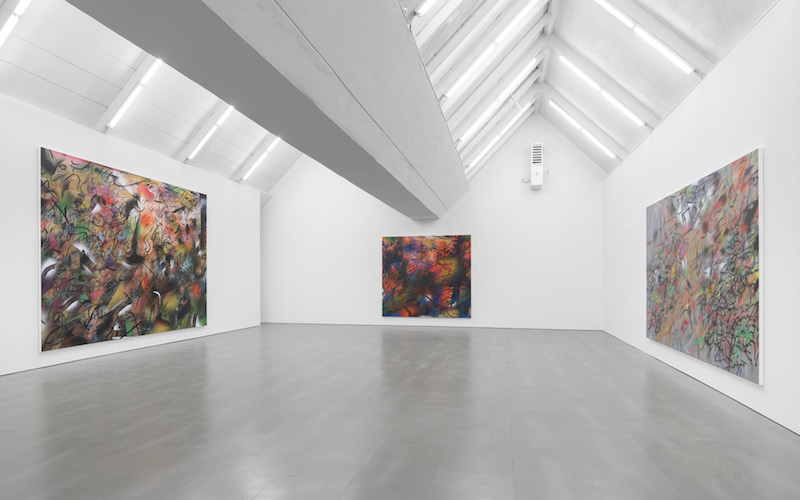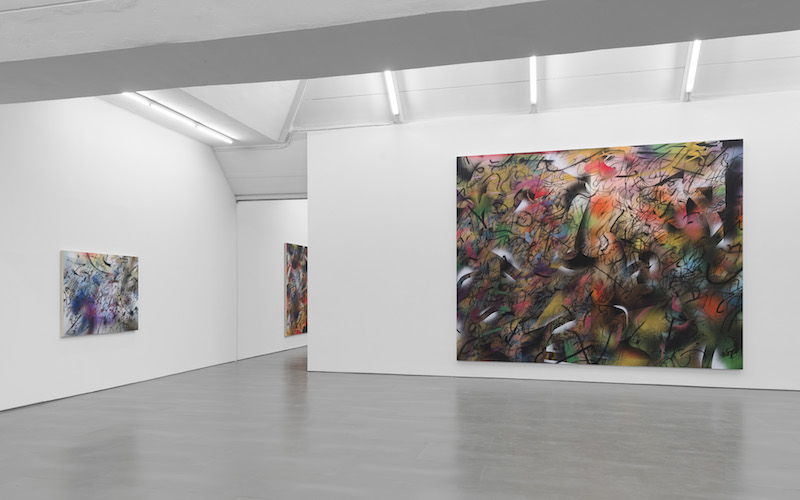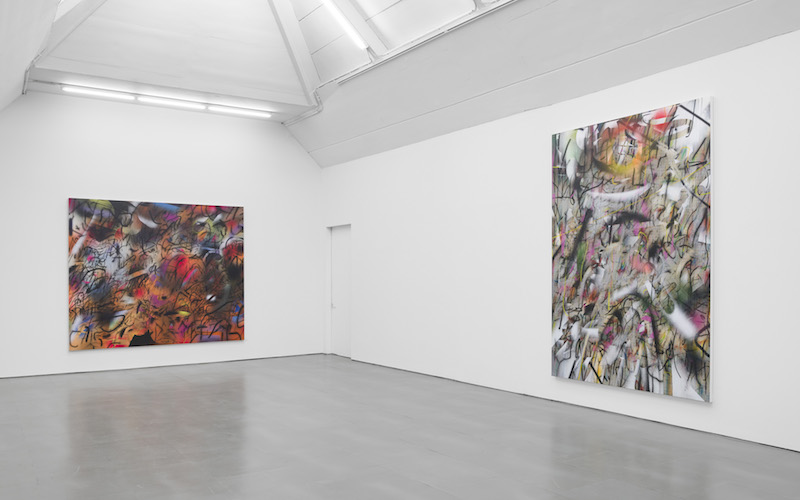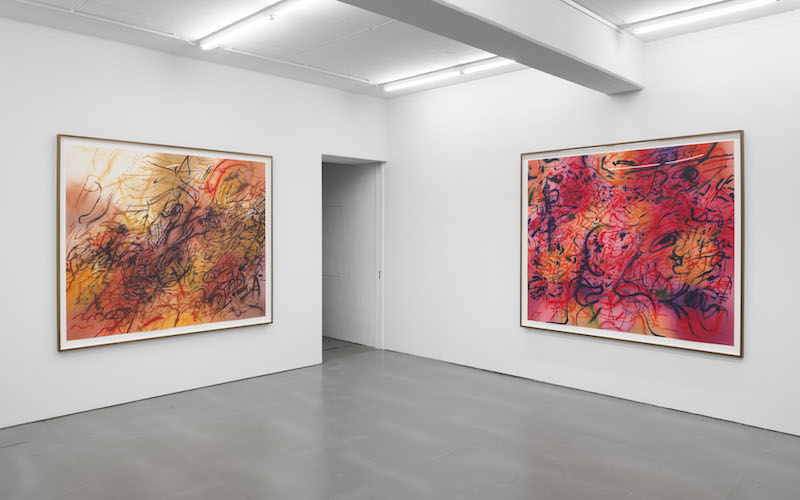by Alice Connolly O’Brien // Oct. 19, 2021
As you arrive in the all-white space of carlier | gebauer, your eyes are immediately fixed on the towering works on canvas by Julie Mehretu. Colossal, layered and rich in meaning, ‘Metoikos (in between paintings)’ marks the third solo exhibition of Mehretu in this space and is contrastingly paired with a suite of her etchings entitled ‘Slouching Towards Bethlehem.’ Present in both Mehretu’s artistic process and her political thinking runs a powerful, painful and human theme of reparation.
Mehretu is a distinguised artist whose work has been celebrated worldwide. While she hails from Ethiopia, she now lives and works in New York City. Within a moment’s glance at her repertoire, it’s abundantly clear how this global experience has influenced her artistic style. Her work is threaded with a cosmopolitan perspective. It evokes real feelings and mobilises real social and political issues, narrating the contemporary experience in an achingly beautiful way.

Julie Mehretu: ‘Metoikos (in between paintings),’ exhibition view at carlier | gebauer, Berlin, 2021 // Courtesy of the artist and carlier | gebauer, Berlin/Madrid, Photo: Trevor Good, © Julie Mehretu
This series of canvases, titled ‘Metoikos (in between paintings),’ is the most recent work of Mehretu, some of which have yet to be named. Looking at them, it’s immediately apparent that their aim is to articulate a complex, layered story. Their size is comparable to a cinema screen and gives you the illusion that you are sitting front row in a theatre, watching a dramatic film unfold. You do not feel like you are looking at a painting, but rather a storyboard depicting a graphic circular tale of birth, connection, injustice and repair. This feeling that you are an observer is emphasized by the all white backdrop provided by the gallery. It’s plain, barren walls create a surreal environment similar to the limbo present in Catholic methodology, perpetuating a narrative omnipresence.
While the pieces appear as fractured mosaics, each stems from a backbone of significance. This collection of canvases incorporates harrowing images from controversial and topical modern events, ranging from scenes of immigrant detention centers and political protests to snapshots of ecological disasters. Mehretu collected these images and, in some cases, harbored them for years, waiting for a suitable moment of inspiration to incorporate them into her art. She then reworked them using photoshop to form the foundation of these paintings. The act of taking a whole image and distorting it feels like a metaphor for the corrupted sense of justice that has triggered the scenes behind the photos themselves. These triggering images serve as a point of entry to articulate stories that aren’t linear or fair, but are honest and biased, much like people themselves.

Julie Mehretu: ‘Metoikos (in between paintings),’ exhibition view at carlier | gebauer, Berlin, 2021 // Courtesy of the artist and carlier | gebauer, Berlin/Madrid, Photo: Trevor Good, © Julie Mehretu
Presented in a graphic palette, the layers appear volatile and eruptive. When you understand their distressed origins, this makes sense. It feels like Mehretu is pointing out that repairing or healing isn’t always pretty or linear, nor should it be. After using these distorted images as a base, she dresses them in layers of paint, screen paint, airbrush and ink. Each canvas is an eclectic mix of smudged saturated lines, luminous wisps, shimmering fragments and tangled graffiti-like sketches. While pieces like ‘Metoikos (she opened her mouth, to breathe lightning)’ are choreographed from a bright but muted palette, other canvases such as ‘Among The Multitude II’ are born from dark, desolate tones. At first glance, the canvas may appear as a singular 2D compounded image, but up close it reveals much more than that. The layers act as skin that protects and rehabilitates the canvas’s tragic past: the distorted images. It feels like every time you look at each piece a new aspect tumbles out from behind the wall of layers and presents itself to you, allowing you to find a new favorite etching or aspect with every viewing.
This multidimensional quality provides each individual with a unique and singular experience. While every viewer probably views each piece as a whole first, their observations then sever. Each person is captivated by a different shade, corner or line first. This divergence from the collective eye feels like a race. Your eyes feel tricked by the instantaneous, and naive, impression of a whole singular piece and overwhelmed by the multitude of elements that have revealed themselves to you. This feels particularly evident in ‘Metoikos (she opened her mouth, to breathe lightning).’ However, once this realisation has subsided, the practice of moving through each aspect, taking in its composition, meaning and angle feels therapeutic, particularly as you flow around the gallery and experience it with each large-scale piece. Each person receives a story from these pieces, but because each person is the captain of their viewing experience, each story is different. There is no singular point of beginning, acceleration, descent or restitution. There is no chronological order.

Julie Mehretu: ‘Metoikos (in between paintings),’ exhibition view at carlier | gebauer, Berlin, 2021 // Courtesy of the artist and carlier | gebauer, Berlin/Madrid, Photo: Trevor Good, © Julie Mehretu
Mehretu’s signature feels softer in this collection than in her previous works. Her previous series ‘Mogamma (2012)’ was far more structured. It used distinct architectural motifs, sharp lines and geometrics as a metaphor for the unfolding socio-economic and political events of the Arab spring. However, with ‘Metoikos (in between paintings)’, Mehretu offers a more contemplative, pared down and intimate response to global events. She describes this sweeping change as a “retreat,” saying, “when I talk about retreat, I mean in that context – a moment of rethinking language, of rethinking collective action and governance. I’m going to take a step back in order to take the parts apart and put them back together.” This statement makes it clear that the theme of repair is crucial to her practice, her materials, thought processes and inspirations.
After moving through the main room of the gallery, the side room and its contents stand in stark contrast, in size, composition and lighting. The experience of seeing these etchings, particularly after leaving the bright, open main gallery space, feels private, like entering a hidden alcove. However, it is not a lonely journey as your experience is immediately lit up by the bright, blazing colours of Mehretu’s canvases titled ‘Slouching Towards Bethlehem.’
While this suite of canvases is smaller than the last, their presence is made just as known. Their palettes are a mix of lively hues with a burning fiery base and feel loud, despite their smaller size. Since this section of the gallery is smaller, their volume is amplified. You feel surrounded by this quartet and compelled to decipher what it is that they are trying to tell you. While their colours are captivating, their articulation is incredibly agitated and insinuates some kind of trauma.

Julie Mehretu: ‘Metoikos (in between paintings),’ exhibition view at carlier | gebauer, Berlin, 2021 // Courtesy of the artist and carlier | gebauer, Berlin/Madrid, Photo: Trevor Good, © Julie Mehretu
Much like ‘Metoikos (in between paintings)’, these pieces are rooted in a deeper meaning. Mehretu used the same technique of distortion and layering to create this series, however, this time she used images of anti-immigration protests to form their bases, snapshots of people who are being held at borders or having conflicts with immigration officers, people trying to repair their own stories.
The four pieces feel connected to each other, like four chapters of a book, however their outcome feels undetermined. This blurry quality was emphasised by Mehretu to reflect the global experience of the pandemic. She successfully depicts this atmosphere of universal uncertainty by giving the viewer pause. You want to decipher what the paintings are telling you, you want to connect them and unearth their reparative stories, however you aren’t quite able to. This impression nods to the floating, yet unnerving, feeling of social and political unrest that arose throughout the pandemic, from racially-motivated violence to police brutality.
This sense of suspension is referenced in the title of the pieces. They were first exhibited at a show at the Marian Goodman Gallery in New York, entitled ‘In The Space Of Half An Hour,’ which paid homage to the story of the second coming in the Bible. In the story, there has just been an apocalypse and the horsemen are faced with an intense moment of total unknown, they don’t know what will happen to them. This led Mehretu to think of the poem ‘The Second Coming’ by William Butler Yeats and its ties to Joan Didion’s 1967 canonical essay ‘Slouching Towards Bethlehem.’ All of the mentioned works explore the devastation experienced by humans moving through moments of precarity in a liminal space. She identified these delicate, yet pressurised, moments with the unknown that the world was experiencing at the time of the works’ conception. Moving deeper into this timely reflection, Mehretu’s show at carlier | gebauer is both breathtaking and harrowing: the panicked lines and manic hues, their pained origins of statelessness and busy layers tell a story of a quest for redress and recovery that is both highly individual and eminently relatable.
This article is part of our feature topic of ‘Repair.’ To read more from this topic, click here.
Exhibition Info
carlier | gebauer
Julie Mehretu: ‘Metoikos (in between paintings)’
Exhibition: Sept. 17–Nov. 13, 2021
carliergebauer.com
Markgrafenstraße 67, 10969 Berlin, click here for map


























